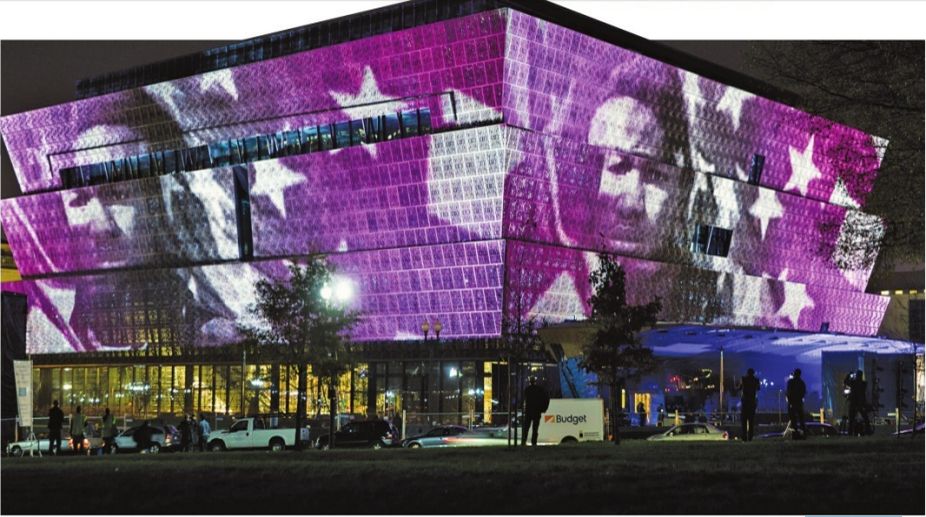My art is my therapy, says artist Neeraj Bakshi
Bakshi says animals have a special role in his theatre, as they seem to connect directly with the observer as the ardent human self, ‘breaking the fourth wall’.

National Museum of African American History and Culture in Washington (PHOTO: SNS)
Pictures of a five-year-old girl from suburban Seattle, dressed up as her heroines – Angela Davis, Rosa Parks and other African-American women who fought for freedom – were shown at the International Center of Photography in New York recently. Soon, they were followed by images of displaced migrants in a Tunisian refugee camp.
Where the museum chooses to display these powerful shows – on the facade of its Bowery building, from dusk to dawn – is a sign of a growing global trend among arts institutions that are trying to make an artistic statement while engaging visitors, both returning and new.
Jurien Huggins, a 24-year-old graphic designer and photographer who was walking by, praised the museum for bringing “its knowledge out into the world and making something like this more accessible”.
Advertisement
Joshua Sandoval Garcia, a 22-yearold abstract artist who strolled by, was struck by the young girl’s face and took his own photos, which he said he would use as a reference “when I have an artist’s block”.
The museum’s executive director, Mark Lubell, said the museum began projecting its rotating series of images beginning in March. “It’s consistent with our mission,” he said, “to conduct a dialogue with the world we live in today.”
To commemorate this year’s Holocaust Remembrance Day, the Museum of Jewish Heritage, in Lower Manhattan, has commissioned a series of black-and-white photographic portraits of some 30 Holocaust survivors, called Eyewitness, that it is displaying in the ground, second and third floor windows on the facade of its building on Battery Place.
The trend dates back centuries: to 18th-century “son et lumiere” shows and fireworks spectacles with wall-like sets in Europe, according to Erkki Huhtamo, a professor in the department of design media arts at the University of California, Los Angeles. These were followed in the 19th century by outdoor projections done with a magic-lantern slide projector.
Today’s technology includes projection mapping techniques that can display images and animations on a surface that is not flat or white.
Even before the Smithsonian National Museum of African American History and Culture, in Washington, opened, it projected a sevenminute video on its facade, depicting milestones in black history to celebrate completion of its exterior construction.
Michael S. Glickman, the president and chief executive of the Museum of Jewish Heritage – whose survivor portraits, by the photographer B.A. Van Sise, have been digitally reproduced on vinyl and measure as much as 5 feet wide and 13 feet high – said this series represents the museum’s desire “to be a fully acceptable site of public testimony, to hear the stories, meet the people, get a more intense, more meaningful, more impactful connection to history.”
One Holocaust survivor whose portrait is on display, Frederick Terna, a 93-year-old Brooklyn artist who spent his childhood in Prague and speaks to groups of teachers at the museum, said “It is my function to be a communicator about what happened,” adding, “If you believe in something, you must act on it.”
The Vivid Festival in Sydney was established in 2009 to stimulate tourism during a slow winter season; according to Ignatius Jones, its artistic director, visitor numbers have skyrocketed from 165,000 in 2009 to 2.3 million last year, which the founders partly credit to their use of innovative lighting and projections.
This year, from late May until midJune, the facade of the Museum of Contemporary Art Australia, also in Sydney, will be decorated with Organic Vibrations, a collaboration between the Australian artist Julia Gorman and the Paris collective Danny Rose (which created The Matter Of Painting in 2016).
This October, Cincinnati will host its first Blink festival, an evening art event with large-scale media and interactive art that will animate buildings throughout 20 city blocks. Brave Berlin, a local design studio, is overseeing the creation of animated installations for the facades of the National Underground Railroad Freedom Center and the Contemporary Arts Center.
Raphaela Platow, the director of the Contemporary Arts Center, said she hoped its installation would draw viewers from outside the city and allow the museum’s building, by Zaha Hadid, to “be perceived maybe in a different light”. She added that “the desire of any institution is to open its doors as wide as possible, to have visitors be challenged, stretched, transformed by art”.
Not all facade projections are authorised or institutionally approved.
In 2014 and 2016, Gulf Ultra Luxury Faction, a group that fights for the rights of workers in Abu Dhabi, where a branch of the Guggenheim Museum is planned, projected messages like “Ultra luxury art, ultra low wages” on the facade of the Guggenheim in New York.
Since 2008, the museum itself has projected artworks by Jenny Holzer and Agnieszka Kurant, among others, on the exterior of its Frank Lloyd Wright building. Describing works like those of the Gulf protest group as “guerrilla projections”, Huhtamo, the design professor, said they would probably remain outnumbered by projections done with permission or by commission.
One possible deterrent to projections’ growth, according to Shannon Mattern, an associate professor of media studies at the New School, could be evening lighting restrictions by municipalities, to protect birds or conserve energy.
Nevertheless, Huhtamo said that he believed that authorised museum projections would continue to proliferate, “as the embrace between the urban and media environment gets more intense,” though he warned that they should not “become a permanent presence, because they would then start to lose their appeal”.
The straits times/ann
Advertisement